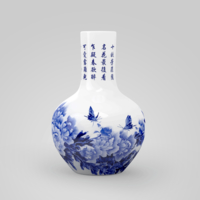Blue and White Porcelain 青花瓷
Dublin Core
Title
Blue and White Porcelain 青花瓷
Subject
Pottery, Porcelain, Folk art
Description
Blue and white porcelain is pottery with a white base and treated with a vibrant blue glaze. It began in the Tang Dynasty (618AD-907 AD) when cobalt started to be imported from Persia. Blue and white porcelain was often portrayed works of the blue wolf and the fallow doe, mythical ancestors of Mongolia, during the Yuan dynasty (1271–1368 AD).
Source
White Porcelain
Date
Tang Dynasty (618-907 AD)
Relation
White Porcelain, Celadon, Enamel Painted Porcelain, Black Porcelain
Format
Hard, Smooth, Blue, White
Type
Craft
Crafts Item Type Metadata
Crafting Methods
Blue and white porcelain is contrived using the color blue, usually from cobalt oxide, to create designs on shaped clean, white clay that is then covered in a layer of transparent glaze and baked in a kiln at high temperatures.
Materials
Ceramic
Usage and Application
The subjects of the figurines span a wide range of bold and brief shapes of wild exaggeration and bright colours with a strong local flavour. They are well received by the local people, who put them as toys and symbols of good fortune and happiness. Every time when the lunar New Year draws near, the local handicraftsmen, with the beautifully painted clay-figurines on shoulders or in hand, would converge on the market and set up stalls in meandering lines. This makes the country fair during the festival more flourishing and exciting. Infused with simple and sincere feelings of the laboring people, the painted clay-figurines reflected the superb creative ability in art of the peasants and are typical articles of folk art. They not only attract the attention of artists, but also appeal very much to people of various fields both at home and abroad.
Interesting Facts
There is an interesting story that took place in 1603, when a Portuguese cargo ship, the Santa Catarina, bearing thousands of pieces of Ming porcelain, was anchored outside of Singapore. A Dutch ship attacked, causing the crew to flee, and the porcelain was appropriated and taken to Europe where it sold so well at auction as to cause considerable "porcelain mania". The porcelain fetched such high prices that it became known as "white gold" by some. Extensive legal proceedings followed to determine whether taking the cargo was an act of illegal piracy, or whether Portugal and Holland were in fact at war at the time.
Collection
Citation
“Blue and White Porcelain 青花瓷
,” CCCH9051 Group 64, accessed July 13, 2025, https://learning.hku.hk/ccch9051/group-64/items/show/37.
,” CCCH9051 Group 64, accessed July 13, 2025, https://learning.hku.hk/ccch9051/group-64/items/show/37.
